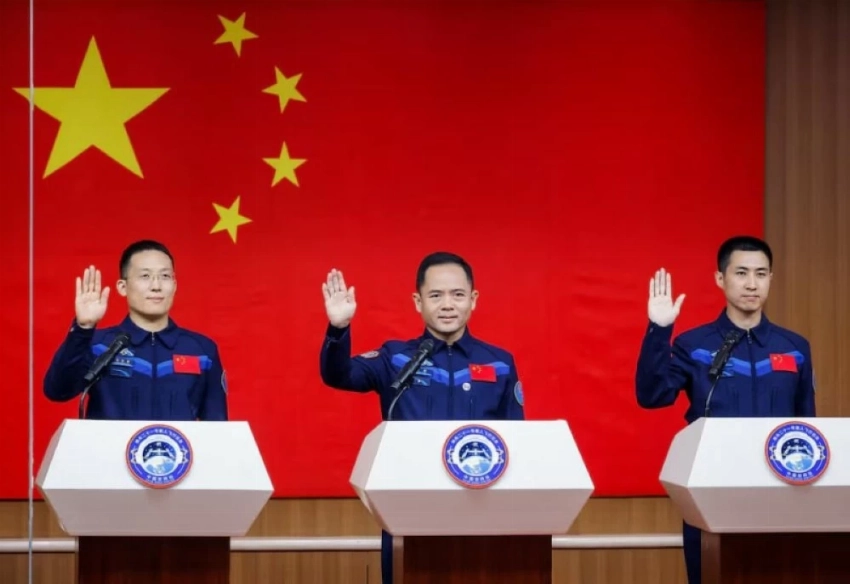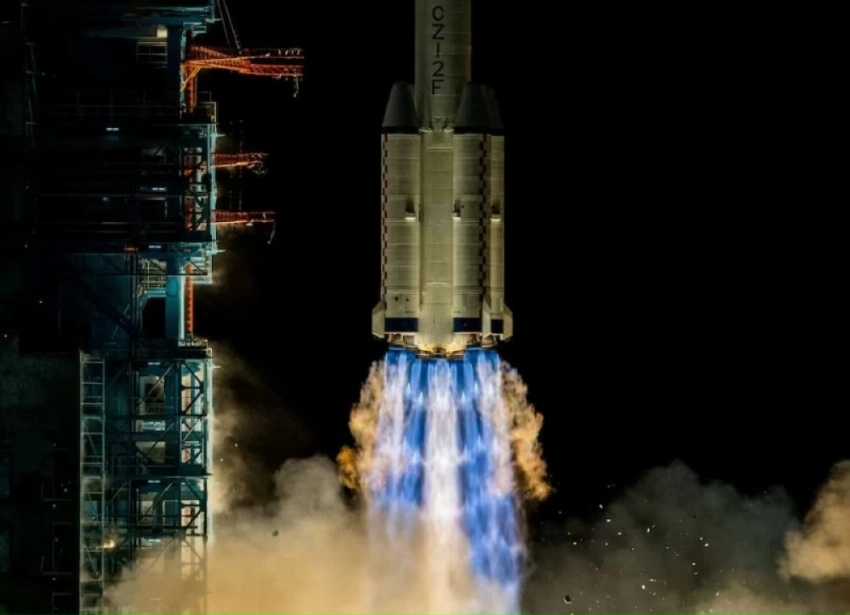هبط ثلاثة رواد فضاء صينيين بسلام في شمال الصين عصر الجمعة، بعد تأخر عودتهم تسعة أيام بسبب اصطدام حطام فضائي بمركبتهم الفضائية، وفقاً لما أفادت به هيئة الإذاعة والتلفزيون الحكومية (CCTV).

وكشفت وكالة الفضاء المأهول الصينية (CMSA) لأول مرة تفويضاً عن أضرار الحطام يوم الجمعة، مشيرة إلى اكتشاف «شقوق دقيقة» في نافذة صغيرة بكبسولة العودة التابعة لمركبة «شينتشو-20».
وأوضحت الوكالة في بيان رسمي: «لا تستوفي الكبسولة متطلبات السلامة لعودة مأهولة، لذا ستبقى المركبة في المدار لإجراء تجارب علمية إضافية».

تأخر 9 أيام
كان من المقرر عودة الرواد إلى الأرض قبل تسعة أيام، بعد إكمالهم مهمة استمرت ستة أشهر على متن محطة «تيانغونغ» الفضائية الصينية الدائمة السكان، وهي جزء من برنامج «شينتشو» المعروف بـ«السفينة الإلهية»، لكن اكتشاف الشقوق دفع الطاقم إلى مغادرة المحطة عبر مركبة بديلة هي «شينتشو-21»، ليهبطوا في موقع دونغفينغ بمنطقة منغوليا الداخلية شمال الصين عند الساعة 4:40 مساءً (08:40 بتوقيت غرينتش).
بداية الرحلة الفضائية
بدأت المهمة في أبريل الماضي وسارت بسلاسة تامة، حتى أجبر الحادث عودة «شينتشو-20» – المقررة أصلاً في 5 نوفمبر – على التأجيل.
ويُعد هذا التأخير استثنائياً في برنامج صيني يعمل بدقة ساعة، حقق خلال العام الماضي إنجازات بارزة شملت إرسال رواد من مواليد التسعينيات، وسجل عالمي في السير الفضائي، وخطط لاستقبال أول رائد أجنبي من باكستان على «تيانغونغ» العام المقبل.
تحديات لوجستية معقدة
وتنتهي كل مهمة «شينتشو» على «تيانغونغ» بتسليم واستلام بين الطاقمين المنصرف والوافد، يستمر عدة أيام مع رسو مركبتين في المحطة، لكن مغادرة طاقم «شينتشو-20» عبر «شينتشو-21» تركت المحطة بدون مركبة صالحة للطيران، مما يعني بقاء الطاقم الجديد (الذي وصل قبل أسبوعين) عالقاً في الفضاء حتى وصول بديل.
ووفق بروتوكولات السلامة الصينية، في حال تعذر العودة الآمنة بسبب عطل، يُطلق مركبة إنقاذ غير مأهولة من الأرض لإعادة الرواد، وأعلنت الوكالة إطلاق «شينتشو-22» في «وقت مناسب مستقبلاً».
خطر الحطام الفضائي المتزايد
وتسلط الحادثة الضوء على التحدي المتفاقم الذي يشكله «النفايات الفضائية» على استكشاف الفضاء، وفي هذا السياق قال إيغور مارينين، عضو أكاديمية رواد الفضاء الروسية في موسكو لوسائل إعلام عالمية: «مع الزيادة الحادةفي الحطام المداري، ارتفعت احتمالات تضرر المركبات والمحطات الفضائية لجميع الدول بشكل ملحوظ».
ورغم أنه أول اضطراب معروف لحطام في مهمة «شينتشو»، إلا أن النفايات الفضائية أعاقت سابقاً رحلات إلى محطة الفضاء الدولية (ISS) التي تقودها الولايات المتحدة وروسيا منذ 25 عاماً، كما اضطرت كبسولة «سبيس إكس» التابعة لناسا إلى المناورة لتفادي شظايا مشتبهة، كما غيرت المحطة مسارها مرات عدة لتجنب الحطام.
وينشأ الحطام من تفكك أقمار صناعية قديمة، حوادث مع أقمار نشطة، أو تجارب أسلحة مضادة للأقمار، ففي العام الماضي، أنتج تفكك قمر روسي قديم 180 قطعة قابلة للتتبع، مما دفع رواد ISS للاستعداد للإخلاء، كما أنتجت مرحلة صاروخ صيني مستنفد نحو 1000 قطعة بعد تصادم محتمل.
وأثار التهديد دعوات لتعاون بين القوتين الفضائيتين الولايات المتحدة والصين للحد من الحطام ووضع قواعد مرور للأقمار، رغم أن قوانين أمريكية تحول دون تعاون ناسا مع بكين.
ومع ذلك، زاد التنسيق بينهما في قضايا السلامة الفضائية أخيرا على أساس غير رسمي، بما في ذلك تنبيهات صينية لمشغلي أمريكا العام الماضي.
يُذكر أن ناسا واجهت موقفاً مشابهاً العام الماضي، حيث تقطعت السبل برائدين أمريكيين تسعة أشهر على ISS بسبب عطل في نظام الدفع بمركبة «بوينغ ستارلاينر».
Three Chinese astronauts safely landed in northern China on Friday afternoon, after their return was delayed by nine days due to a collision with space debris, according to the state broadcaster CCTV.

The China Manned Space Agency (CMSA) revealed for the first time on Friday the extent of the damage caused by the debris, noting the discovery of "tiny cracks" in a small window of the return capsule of the Shenzhou-20 spacecraft.
The agency stated in an official announcement: "The capsule does not meet the safety requirements for a manned return, so the spacecraft will remain in orbit for additional scientific experiments."

9-Day Delay
The astronauts were originally scheduled to return to Earth nine days ago, after completing a six-month mission aboard the Chinese Tiangong space station, which is part of the Shenzhou program known as the "Divine Vessel." However, the discovery of the cracks forced the crew to leave the station via an alternate vehicle, Shenzhou-21, landing in Dongfeng, Inner Mongolia, northern China at 4:40 PM (08:40 GMT).
Beginning of the Space Mission
The mission began last April and went smoothly until the incident forced the return of Shenzhou-20 – originally scheduled for November 5 – to be postponed.
This delay is exceptional in a Chinese program that operates with clock-like precision, achieving significant milestones last year, including sending astronauts born in the 1990s, a world record in spacewalks, and plans to welcome the first foreign astronaut from Pakistan to Tiangong next year.
Complex Logistical Challenges
Each Shenzhou mission to Tiangong ends with a handover between the departing and arriving crews, lasting several days with two spacecraft docked at the station. However, the departure of the Shenzhou-20 crew via Shenzhou-21 left the station without a flyable spacecraft, meaning the new crew (which arrived two weeks ago) was stranded in space until a replacement arrived.
According to Chinese safety protocols, if safe return is not possible due to a malfunction, an uncrewed rescue vehicle is launched from Earth to bring the astronauts back, and the agency announced the launch of Shenzhou-22 at a "suitable time in the future."
Increasing Danger of Space Debris
The incident highlights the growing challenge posed by "space debris" to space exploration. In this context, Igor Marinin, a member of the Russian Academy of Astronautics in Moscow, told global media: "With the sharp increase in orbital debris, the chances of damage to spacecraft and space stations for all countries have significantly risen."
While this is the first known disruption from debris in a Shenzhou mission, space debris has previously hindered flights to the International Space Station (ISS), led by the United States and Russia, for 25 years. The NASA-operated SpaceX capsule had to maneuver to avoid suspected debris, and the station has changed its orbit several times to avoid debris.
Debris arises from the breakup of old satellites, collisions with active satellites, or anti-satellite weapon tests. Last year, the breakup of an old Russian satellite produced 180 trackable pieces, prompting ISS astronauts to prepare for evacuation, while a spent Chinese rocket stage generated about 1,000 pieces after a potential collision.
The threat has sparked calls for cooperation between the space powers of the United States and China to reduce debris and establish traffic rules for satellites, although U.S. laws prevent NASA from collaborating with Beijing.
Nonetheless, coordination between them on space safety issues has recently increased on an informal basis, including Chinese alerts to American operators last year.
It is worth noting that NASA faced a similar situation last year, where two American astronauts were stranded for nine months on the ISS due to a malfunction in the propulsion system of the Boeing Starliner vehicle.


0 تعليق